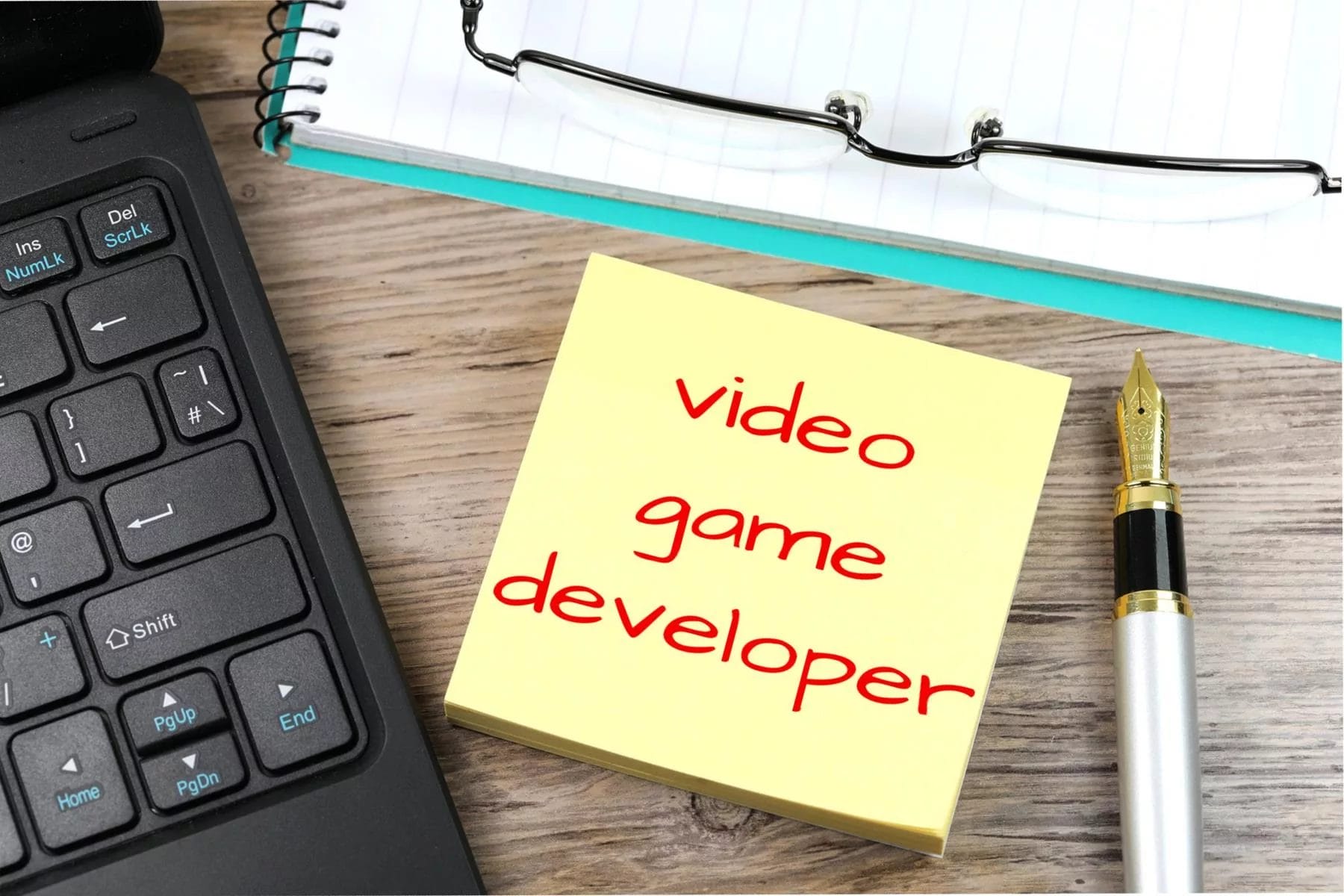Game development is a very complex/risky and multi-stage process that usually involves various teams working together during a long period of time to create an engaging and entertaining experience for players.
From concept to release, a game can take from months to years to be developed, involving a significant amount of planning, design, coding, testing, and polishing.
In this article, I will outline the five key stages of the game development process, providing an overview of what each stage involves and how they contribute to the final game released into the market.

game development process – 5 stages of game development
Game development process
Game development is a complex process that involves several stages, each with its own set of challenges and requirements.
The following are the general stages of game development:
Pre-Production:
This stage involves conceptualizing and planning the game. The game idea is developed, and a game design document is created. The game design document outlines the game’s mechanics, gameplay, story, characters, art style, sound design, and target audience. A team of designers, programmers, artists, and producers work together during this stage to create a solid foundation for the game. This stage typically involves several steps, including:
- Game Concept: The game concept is the initial idea or inspiration for the game. It could be a storyline, a unique game mechanic, a setting, or a character. The game concept is developed into a clear and concise game pitch that can be easily understood by the team and stakeholders.
- Game Design Document (GDD): The game design document is a comprehensive document that outlines the game’s design and mechanics. It includes the game’s story, setting, gameplay mechanics, characters, levels, and progression. It also includes technical details such as the game engine, programming languages, and platforms.
- Target Audience: Defining the target audience is critical for developing a game that appeals to a specific group of players. The target audience includes demographic information such as age, gender, location, and interests. The game’s design, story, and marketing strategy are all influenced by the target audience.
- Team Building: The pre-production stage is also when the development team is assembled. The team typically includes game designers, programmers, artists, and producers. The team’s size and composition depend on the scope and complexity of the game.
- Budgeting: The pre-production stage is also when the game’s budget is established. The budget includes the costs of development, marketing, and distribution. Budgeting is critical for ensuring that the game is financially viable and profitable.
- Prototyping: Prototyping involves creating a simple version of the game to test the mechanics and gameplay. It is an essential step in the pre-production stage as it allows the team to identify any design flaws or technical issues early on.
The pre-production stage of game development is a critical step that lays the foundation for the entire game development process. It involves defining the game concept, creating a game design document, identifying the target audience, building the development team, budgeting, and prototyping. A well-planned pre-production stage sets the stage for a successful game development process.

Production:
Once the game design document is finalized, the production stage begins. This stage involves creating the game’s assets, such as 3D models, animations, and music. The game engine is also developed, which is the software that runs the game. Programmers work on creating the gameplay mechanics, user interface, and artificial intelligence for the game. Artists create the game’s visual elements, including characters, environments, and effects. This stage typically involves the following steps:
- Game Engine Development: The game engine is the software that runs the game. The engine is responsible for rendering graphics, handling input from the player, managing sound effects, and implementing game mechanics. The engine is developed during this stage, and it determines how the game will look and feel.
- Programming: Programmers write the code that implements the game mechanics and features. They work closely with the game designers to ensure that the game functions as intended. Programmers also implement the user interface and controls.
- Art and Animation: Artists create the visual assets for the game, including characters, environments, objects, and special effects. They work closely with the game designers to ensure that the art style and visuals match the game’s overall theme and tone. Animators create animations for the characters and objects in the game, including movements, attacks, and special abilities.
- Sound Design: Sound designers create the audio assets for the game, including sound effects, music, and voice acting. They work closely with the game designers to ensure that the audio matches the game’s theme and tone.
- Level Design: Level designers create the game’s levels and environments. They work closely with the game designers and artists to create visually appealing and challenging levels that are fun to play.
- Quality Assurance (QA): QA testers play the game to identify and report bugs, glitches, and other issues. The development team then fixes the issues and releases updates to the game.
- Project Management: Producers and project managers oversee the development process, ensuring that the game is developed on time and within budget. They coordinate the efforts of the development team, communicate with stakeholders, and make sure that the game meets the requirements set forth in the game design document.
The production stage of game development is where the game is actually built. It involves developing the game engine, programming, art and animation, sound design, level design, quality assurance, and project management. This stage is the most time-consuming and challenging stage of game development, requiring a high level of technical expertise and collaboration between team members.
Post-production:
The post-production stage of game development is the final stage in which the game is polished, tested, and prepared for release. This stage typically involves the following steps:
- Testing and Debugging: The game is extensively tested to identify and fix any remaining bugs, glitches, or issues. QA testers play the game to ensure that it is stable, performs well, and meets the requirements set forth in the game design document. The development team then fixes any remaining issues and makes final adjustments to the game’s mechanics, levels, and user interface.
- Localization: If the game is intended for a global audience, localization is essential. Localization involves translating the game’s text, audio, and visuals into different languages and adapting the game’s content to local cultures and customs.
- Certification: Before a game can be released on a platform such as Steam, PlayStation, or Xbox, it must pass certification by the platform owner. The platform owner tests the game for quality, security, and compliance with platform-specific requirements. The development team works closely with the platform owner to ensure that the game meets all certification requirements.
- Marketing and Promotion: Once the game is finalized and ready for release, marketing and promotion efforts begin. This involves creating trailers, screenshots, and other marketing materials that showcase the game’s features and gameplay. The development team works closely with the publisher or marketing team to create a marketing strategy that targets the game’s intended audience.
- Release and Support: Finally, the game is released to the public. The development team continues to provide support and updates for the game to address any remaining issues or to add new features. They also collect feedback from players to improve the game further and plan for future updates or sequels.
The post-production stage of game development is the final stage where the game is polished, tested, and prepared for release. It involves testing and debugging, localization, certification, marketing and promotion, and release and support. This stage is critical for ensuring that the game meets the quality standards set forth in the game design document and that it is well-received by the intended audience.
Release:
Once the game has been tested, debugged, and polished, it’s time to release it to the public. This is an exciting and crucial time for the development team as they’ve spent months, sometimes even years, working on the game, and now they get to see how players react to it. The release process can vary depending on the platform(s) the game is being released on, but generally, it involves the following steps:
- Platform-Specific Requirements: Each platform has its own set of requirements and guidelines for releasing games. The development team must ensure that the game meets these requirements, which could include technical specifications, content guidelines, and other rules.
- Distribution: The game needs to be distributed to the various platforms where it will be made available for purchase or download. This could involve working with a publisher or directly distributing the game to platforms such as Steam, Epic Games Store, PlayStation Store, Xbox Live, or the App Store.
- Promotion and Marketing: To generate buzz and attract players, the development team will typically launch a marketing and advertising campaign. This could include creating trailers, social media posts, and other promotional materials that showcase the game’s features and gameplay.
- Launch Day: Finally, it’s time to release the game. On launch day, the game becomes available for purchase or download on the various platforms where it’s being released. The development team will typically monitor social media, reviews, and other feedback channels to see how players are reacting to the game.
- Post-Launch Support: Even after the game is released, the development team will continue to provide support, including patches and updates to address any bugs or issues that players encounter. They may also add new features or content to the game based on player feedback.
Releasing a game involves ensuring that it meets platform-specific requirements, distributing it to the appropriate platforms, launching a marketing campaign, releasing it on launch day, and continuing to support the game post-launch. It’s a crucial stage in the game development process, as it’s when the game is finally made available to the public, and the development team can see how players react to their creation.
Post-Release:
After the game is released, the development team continues to support the game with updates and patches to fix any issues that arise. They also release additional content, such as downloadable content (DLC), expansions, and updates, to keep players engaged and interested in the game. This stage is crucial to keep players engaged and interested in the game, and it involves several activities:
- Patches and Updates: After a game is released, players may encounter bugs, glitches, or other issues. The development team monitors feedback channels, such as social media and forums, to identify these issues and release patches and updates to fix them. These updates may also improve game performance, add new features, or balance the gameplay.
- Downloadable Content (DLC): To keep players engaged and interested in the game, the development team may release additional content, such as new levels, characters, items, or game modes. This content is usually sold as DLC, and it can provide players with new challenges and experiences in the game.
- Expansions: An expansion is a significant addition to the game, often adding new gameplay mechanics, features, and content. Expansions are usually sold as a separate product, and they can significantly expand the game’s lifespan and replayability.
- Community Management: The development team also interacts with the game’s community by answering questions, addressing concerns, and gathering feedback. This can help identify issues or features that players want to see in the game and can inform future updates and DLC.
- Marketing: Even after the game is released, the development team may continue to promote the game through social media, advertisements, or events. This can attract new players to the game and keep the existing player base engaged.
In summary, post-release support is a crucial stage in the game development process that involves releasing patches and updates, creating new content through DLC or expansions, community management, marketing, and gathering feedback. This stage can significantly impact a game’s success and can extend the game’s lifespan and engagement.
The game development process is a collaborative effort that involves various professionals, including game designers, programmers, artists, and producers. It can take anywhere from several months to several years to develop a game, depending on its complexity and scope. Successful game development requires careful planning, attention to detail, and a commitment to creating a fun and engaging player experience.
Conclusion:
As we have been able to see in this answer, game development process is quite a complex and dynamic journey that involves many different stages, from initial concept to post-release support. Each stage, itself, requires a different set of skills, tools, and expertise, and successful games are the usually the result of a cohesive and well-coordinated development team (with some bit of luck).
By understanding these five key stages of game development, gamedevs/indiedevzls can approach each step with a clear strategy and goal in mind, leading to a successful final game to be enjoyed by players of all ages around the globe.
You can find more articles to this and other topics on our blog.
A game developer that wants to share its knowledge and experience with other game developers-





